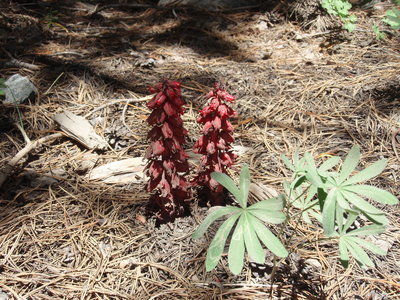I’d heard stories about the glorious wildflower displays in the Sierras, especially this year with all the snow melt, but nothing could prepare me for how many beautiful sights I would discover on the west side of Lake Tahoe last month.
As I explored and hiked the forest trails, I thought of what it might have been like to be a Native American from the Washoe tribe. How did they use some of these plants, and would I find similar species used by our local Ohlone tribes?
I sketched, photographed and identified (or tried to) more than 49 different wildflowers and admired many more native plants, trees and shrubs. The weather was perfect for hiking and the sky as blue as the water of the lake.
Lake Tahoe and the land surrounding the lake were once home to the Washoes, who wintered in Carson Valley and spent their summers on the shores of the lake, hunting, fishing and gathering food for the winter. I’m sure they admired the flower displays as I did.
Red-twig dogwoods bloomed along stream banks. The tribes used the berries as food, both fresh and dried and cooked. The berries were eaten to treat colds and slow bleeding. The inner bark was used as a tobacco, either by itself or mixed with manzanita. The bark could also be used as a dye. The wood used for bows and arrows, stakes and other tools.
Pink Sierra currants sported beautiful pink flower clusters and edible blue-black berries. Tribes relished the berries fresh and dried them for later use in the winter. All species in the genus, including our own native canyon gooseberry, have berries high in Vitamin C. When dried, they were mixed with animal fat and eaten while traveling.
Wood’s roses were in full bloom, their dark pink flowers fragrant in the sun. A variation of the species grows in every western state and throughout Canada. The petals can be eaten raw after the bitter white base is removed. The seed or rose hip contains 24 times as much vitamin C as oranges, as well as vitamins A and E, and is also a fairly good source of essential fatty acids — unusual for a fruit. A poultice of chewed leaves was used on bee stings. Various parts of the plant were used to treat burns, sores, swelling and wounds and used to make tea-like beverages. All this from a plant that is beautiful, too.
A real looker, the Mariposa lily caught my eye. Blooming along the trail to McKinney Lake, I thought of how the Washoe would consider these plants a great find, digging up the sweet bulbs to be eaten fresh. We almost missed the Sierra tiger lily, mistaking it for the columbines that were nearby. Their orange flowers are much larger, but both are stunning to see in the damp meadows.
Other flowers I encountered were monardella, penstemon, yarrow, lupine, larkspur, arnica, thalictrum, snowberry, giant hyssop, aster, Solomon’s seal, corn lily, mimulus, paintbrush, western burning bush, cow parsnip, wintergreen, phacaela, golden rod, epilobium and sidalcea, to name just a few. I was in seventh heaven.
I loved seeing all the rein orchids that were in full bloom. Pinedrops emerged from the ground with their urn-shaped, downward-facing flowers. The plants exist for most of their life as a mass of brittle but fleshy roots, living in a parasitic relationship with mycorrhizal fungi, from which they derive all their carbon. Another unusual plant I saw pushing up from the ground was the bright scarlet snow flower (Sarcodes sanguinea), a parasitic plant that also derives nutrients from mycorrhizal fungi. Nature has come up with many ways to survive, and these are but two good examples.
Tribe members used grasses and pine needles for baskets, willows for household goods, wild onions for food and flavoring and acorns from oaks as a food staple and for dyes, medicines, games, toys and construction materials. I’m sure they loved to see the wildflowers for their pure beauty, as I did.
Jan Nelson, a landscape designer and California certified nursery professional at Plant Works in Ben Lomond, will answer questions about gardening in the Santa Cruz Mountains. E-mail her at ja******@*ol.com, or visit www.jannelsonlandscapedesign.com to view past columns and pictures.












